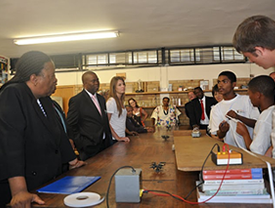| 50% of you think that the South African Government has the potential to make the biggest impact on reducing carbon emissions in South Africa; | |
| 8% opted for the technology sector; and | |
| 42% opted for private industry. |
Shuttle Discovery landed for the last time at Florida’s Kennedy Space Centre on 9 March 2011. Discovery has completed 39 space voyages (its first being on 30 August 1984), has spent a total of 365 days in space and travelled more than 238 million kilometres during it’s lifetime.

 |
Students, who are supported in their studies by SKA South Africa, do a spiral galaxy activity with children at a school in Carnarvon | |
 |
Ms Naledi Pandor, Minister of Science and Technology, listens to the learners’ explanations while they participate in experiments. | |
 |
Learners explain the outcome of an experiment in their new laboratory at Carnarvon High School. |
Big things are happening in the little town of Carnarvon. The prospect that the world’s biggest radio telescope may be built there has created much excitement and lead to great educational developments at schools in the area.
While African scientists and engineers are building a world class radio telescope in the Karoo region of the Northern Cape Province in South Africa, the project is also reaching out to schools in the area to boost science and mathematics teaching and learning.
The small town of Carnarvon is near the area that has been selected as a potential site to build the core of the world's largest radio telescope namely the Square Kilometre Array (SKA). South Africans are already constructing a precursor telescope – MeerKAT – outside Carnarvon, while the international radio astronomy community is still deciding whether this mega science instrument will be built in southern Africa or Australia. KAT-7, an engineering prototype for MeerKAT, is already complete and consists of seven radio dishes.
The SKA South Africa Project has committed itself to improving educational resources in the area, forming partnerships with the private sector to support local schools, and working closely with the Northern Cape Department of Education. On 25 February Ms Naledi Pandor, Minister of Science and Technology, officially launched two new laboratories at Carnarvon High School – a computer and a science laboratory.
The opening of the new laboratories at a local high school is part of an ongoing process to create a climate where young people from nearby towns, especially Carnarvon and Williston, can engage with science and technology and explore the potential of the SKA project.
A donation of R750 000 from the Universal Service and Access Agency of South Africa was used to build and equip the computer laboratory, while software and training were obtained from Learn Things, Mindset and Microsoft. The new cyberlab now boasts 43 desktop computers, a laptop, an interactive white board and a printer, as well as an Internet connection. Optic 1, the company that built the high voltage power cable and optical fibre cable from Carnarvon to the telescope site, donated R50 000. This secured new equipment for the science laboratory at Carnarvon High, as well as for laboratories at two primary schools nearby. The United States Embassy in Pretoria has donated R20 000 towards books for a local primary school.
The SKA South Africa project facilitated the employment of two qualified teachers for Carnarvon High School to teach mathematics, science and information technology. It also funds tertiary students, ranging from artisan apprentices and technicians to university students at all levels. To date, 293 students and researchers have benefited from SKA South Africa bursaries and scholarships, including many students from other African countries. Bursaries go to physics and engineering students and a special effort is made to attract women and black students to these fields. There are also bursaries for technician training. Support for artisan training focuses on bringing students from the towns near the telescope site to study at the Northern Cape Further Education and Training Urban College in Kimberley.
During site visits to the Northern Cape, undergraduate students who hold SKA bursaries have the opportunity to participate in educational outreach activities designed to excite the learners about the leading role that their province is playing in the future of astronomy in South Africa, Africa and the world.
